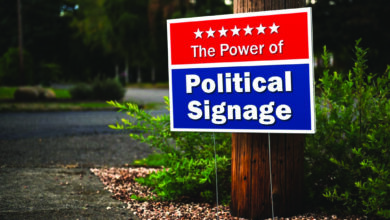It’s been documented that LEDs have surpassed other lighting methods in signage as the preferred choice. However, even over the last five years, there have been frequent improvements to LEDs.
“LEDs have continued to improve in efficiency over the past five years,” says Gray Lankford of GENLED Brands. “We’ve also seen color binning yields tighten, allowing the cost to decrease as more of the visibly acceptable product yield can be utilized.”
Haitz’s Law has dictated that costs will continue to fall as LED quality increases. This is the number one reason why LEDs are trusted and used more frequently today than ever before.
“Efficacy has increased to a point where LEDs can beat pretty much any other normal lighting technology in terms of lumens per watt,” adds Mike Bluhm of SloanLED. “This results in lower energy costs, and fixture costs decrease since you need fewer LEDs for the same number of lumens. You can also reduce the heatsink size since you’re generating less heat. Quality of light has steadily improved to where LEDs can rival or outperform most other light sources.”
Also, fewer modules are required to light a larger area, which means less installation work, explains Leslie Donels of GOQ LED America. This means that sign shops can also save money on labor costs while customers reap the benefits of a high-performance sign.
Bluhm agrees: “The increased efficacy in combination with lenses allow the user to install less product. Less product means less labor cost, thus easier to use.”
This “less is more” benefit presents real cost savings without sacrificing quality.
“As efficiencies have increased, fixtures and modules with lower power and greater lumen output have been designed,” Lankford says. “Therefore, we can have fewer fixtures or modules used in lighting our signs.”
In the past, sign makers were cautious about how many LEDs were used, and their locations. Hot spots and shadows caused problems with uniform illumination and made the sign appear less than professional. Today, high-performance LEDs can make up for poor placement.
“Due to the proliferation of using optics in signage LED products, the exact placement of the product is not as critical as it once was,” explains Bluhm. “Shadows and light separation from sharp corners in signs have been dramatically reduced by these optics, which move the light sideways versus straight up.”
Additionally, new applications have popped up due to the advancements in LED technology. Instead of being limited to channel letter or traditional sign box projects, LEDs have branched out to be included in other ways.
“Dye-sublimation fabric display cases have become very popular in Europe, and we anticipate this application will transition over to North America,” Bluhm begins. “Illuminating a single-sided display case that is 60mm deep is extremely challenging, but perimeter LED lighting solutions have become more readily available. These side-lighting solutions have limitations in that the LEDs with special tight viewing angle optics can only send the light so far across the fabric.” Backlighting solutions accommodate all sizes, but they do require special optics as not to create a hotspot on the faces.
Even with the latest and greatest products on the market, there is always room for improvement. It’s the reason why the iPhone receives regular upgrades and launches with new versions. LEDs will follow that same pattern, giving sign makers ideas for new methods and offering benefits that will improve on older processes.




